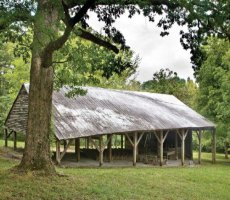The 1875 Reconciliation Bivouac, a Civil War living history event, will be held at the historic National Campgrounds in Greenback, TN on June 14-16. The weekend is sponsored by the Knoxville Civil War Round Table, the Greenback historical Society, the National Campground Revival Committee, and the Village of Greenback. This will be a unique Civil War event probably never to be repeated. Here is the info:
You are invited –
1875 RECONCILIATION BIVOUAC
LIVING HISTORY WEEKEND
Greenback, TN JUNE 14-16, 2024
In 1873, a group of Union and Confederate veterans and their families met for
religious services in Greenback, Tennessee. The next year, using lumber donated
by local farmers, an open-air tabernacle shed was constructed with religious
services held there EVERY year since. The National Campground Association, the
Greenback Historical Society and the Knoxville Civil War Round Table are
honored to produce this living history weekend at the National (Union)
Campground, a nationally and state-recognized historic site which is part of the
Tennessee Civil War Trail.
1875 attire requested. Worship services Saturday and Sunday.
History tours on site. Sutler’s Row. Vintage baseball games.
1875 music. Antique/Historic Quilts. Women’s Temperance League.
On site rustic camping. Nearby RV camping. No weapons.
The general public are invited. For additional general information or to register as
a sutler, musician, re-enactor or other historic participant, contact the
KCWRT at ustresagt@aol.com.
Here is more info on the site and original event:
In November 1863, Confederate General James Longstreet laid siege to Knoxville, where Union General Ambrose E. Burnside’s forces were stationed. In late November, following a pivotal Federal triumph at Chattanooga, General William T. Sherman directed his corps northward through the largely Unionist Loudon County toward Knoxville to lift the siege. Sherman’s troops bivouacked in several locations in the county, transforming the pastoral countryside into a vast armed encampment.
In the aftermath of the war, the landscape was transformed yet again for a more peaceful purpose. In 1873, R. Peter Hughes sold tracts of land to be utilized as a camp meeting ground for religious services and fellowship. According to archived records of the camp, “A cadre of well-intentioned Christian gentlemen conceived the notion of a grand convocation to advance the cause of our Great Redeemer and unite the disparate denominations in Christian commune, thus healing the divisions wrought by the late national tribulations.” A portion of the board of trustees were former Confederates, while others were staunch Unionists, but both factions set aside those competing loyalties to overcome the bitterness of war and compelled others to do the same. Initially named the Union Camp Meeting, the grounds were later christened the National Campground. The first meetings were held in a large tent.
In 1874, the Tabernacle Shed was constructed from timber donated by neighboring farm owners. It still stands just beyond the tree line to your left, the sole surviving original structure, appearing much as it did then. Legions traveled by horse and carriage to attend the two-week-long services held around the clock. Camp meetings have been held annually since 1873, and presently services are held nightly over five consecutive evenings each September. The National Campground was added to the National Register of Historic Places in 1972.
